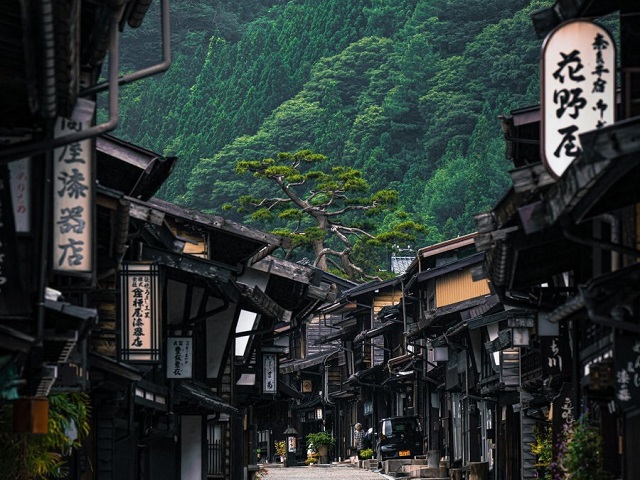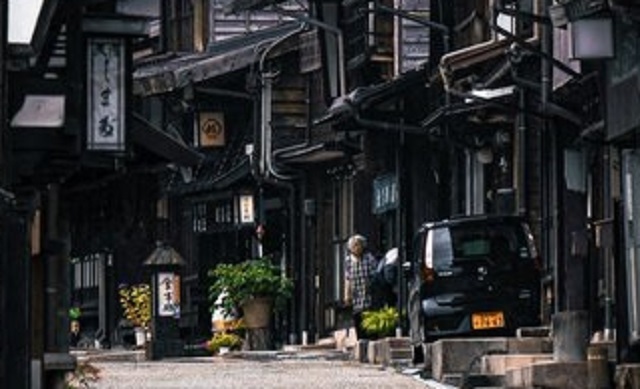
Nagano village was once a major stop on the Kyoto-Edo route, and the neighborhood looks much the same centuries later.
In the early 1600s, following the end of the feudal Sengoku era, the seat of de facto power in Japan moved from Kyoto to Tokyo (or Edo, as it was called in those days). However, while the Shogun took up residence in Tokyo, the Emperor stayed behind in Kyoto, and so both cities continued to be important political, cultural, and commercial centers of Japanese society.
This meant a steady stream of people flowed between the two towns, prompting the development of official semi-maintained overland routes between Kyoto and Tokyo. Since wheeled transportation was prohibited (picture any samurai movie in your head, and realize you hardly ever see people riding around in animal-drawn carts), most made the journey on foot, and since you can’t walk all the way from Kyoto to Edo in a day, a number of shukubamachi, or post towns, sprang up as inns, tea houses, and other facilities were built to accommodate travelers.
Of course, wheeled transportation, whether by train, bus, or private car, is how people today go between Tokyo and Kyoto, so many of the post towns have disappeared or thoroughly modernized. The past isn’t an intangible memory, though, but remains part of the current architecture in the town of Shiojiri, Nagano Prefecture, as this breathtaking photo from Japanese photographer and Twitter user @Hisa0808 (ag.lr.88 on Instagram) shows.

“This post town in Nagano is totally the Edo Period,” tweets @Hisa0808, and it’s hard to argue. The traditional exteriors all look like the sort of place a sandal-sore pilgrim, peddler, or samurai might have stepped into for a hot meal or place to sleep hundreds of years ago.
長野県の宿場町がもはや江戸時代。 pic.twitter.com/PaowMLxMMM
— Hisa (@Hisa0808) May 11, 2021
A few subtle details really help preserve the historical aura of this part of Shiojiri, which is known as Narai-juku. First, the local businesses have seemingly settled on brushstroke fonts and enclosed light sources for their signs, giving them the outward appearance of candlelit lanterns. Second, though as a modern city residents obviously want the convenience of electricity, Narai-juku doesn’t have exposed, above-ground powerlines, going to the extra expense for aesthetics (a decision not every town in Japan makes).
Reactions to @Hisa0808’s photo have included:
“Wait, you took this now, in the present?”
“I hope they’ll always keep the town looking like this.”
“It looks like a painting.”
“Well, now I know where I’m going on my next trip!”
Other photos tweeted in response show how atmospheric Narai-juku looks at night…
奈良井宿いいですよね。前に行って良かったので、また行きたいと思ってます。 pic.twitter.com/irpgyok2Qh
— じゃりてん (@jarite_n) May 11, 2021
…and how little it’s changed in the last 100-plus years.
雰囲気的に何も変わってないですよね~。( ´ー`) pic.twitter.com/QUTy9hyzo8
— ピトフーイ (@7Z1skIWtjpBwPnR) May 11, 2021
Oh, and if the mountains look particularly beautiful, that might be because Narai-juku is one of the highest-elevation points on the Nakasendo, the more inland route between Kyoto and Edo. Still, don’t let them distract you from noticing the local grannie who makes an appearance in @Hisa0808’s photo.

And if this has you too planning a trip to see Nara-juku for yourself someday, don’t forget that @Hisa0808 has also shown us just how awesome Nagano’s best castle is.
Source, images: Twitter/@Hisa0808
● Want to hear about SoraNews24’s latest articles as soon as they’re published? Follow us on Facebook and Twitter!

No hay comentarios:
Publicar un comentario